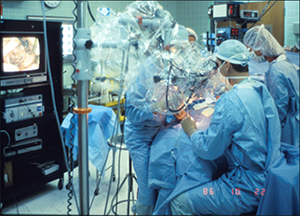
It is not possible to treat all patients with the same surgical technique. Technique selection must fit the patient's problems. TMJ pathology can be treated using procedures such as anthroscopy, disk removal or disk repair.
Arthroentesis, or lavage, is the irrigation or washing out of the TMJ. Lavage is the least invasive procedure we offer. It may provide some relief by reducing frictional interferences that could lead to further disk displacement. The benefit of lavage is a rapid reduction of inflammatory pain. Mandibular rest and medication may be of similar benefit.
Arthroscopy is a minimally invasive surgical procedure. It involves inserting an arthroscope into the TMJ through a small incision. Arthroscopy can be used to evaluate an acute trauma, limited range of motion cases and painful TMJs.
Microscopic disk preservation surgery is one approach that may be applied to disk displacement. When the complexity of structural deformation is clearly understood, it is apparent that disk preservation means entirely different things to different surgeons. However, with magnification of up to 10x from a surgical microscope and with improved illumination, the structures of the TMJ take on added complexity. With this improved visualization of the surgical pathology, one can gain a better appreciation of the endpoint for the surgical repair. That endpoint is the normally structured joint, and perhaps microscopic surgery, better than any other technique, allows for the re-creation of near-normal structural anatomy of the intra-articular and extra-articular structures of the TMJ.
Disk Repair – With microscopic surgery techniques, it is possible to reposition the displaced disk to halt further deterioration of the TMJ. Patients must meet certain criteria to be considered for disk repair surgery.
If a disk is too deranged and cannot be repaired, a diskectomy procedure to remove the disk is considered. Replacing the disk with fat, muscle and dermis are replacement techniques.
Fat Grafts - Fat is highly viable as a transplanted tissue and resists scar formation. The autologous fat graft is Dr. Piper’s preferred technique for disk displacement. Disk replacement with autologous fat in a child can stimulate growth of the mandibular condyle. This enhanced condylar growth may completely correct the skeletal open bite deformity.
Muscle Flaps - using the temporalis muscle precranial flaps as a disk replacement.
Dermis - a dermal graft involves taking cartilage from the ear and using it as a disk replacement.
When a patient’s condyle has deteriorated to the point that in no longer provides a stable foundation for the mandible, a condylar bone graft is considered for reconstruction of the mandible.
When there has been a 50% or greater amount of bone degeneration in the joint, artificial joint surgery may be necessary to restore the patient’s joint and occlusion. The downside, especially, in younger patients, is that the artificial joint will have to be replaced as it wears over time. Total joint replacement components are available for the most severe joint degenerative conditions.
Dr. Piper uses the Stealth computer assisted surgery system from Medtronic, USA to perform surgeries on patients.
Following surgery, a splint may be used to immobilize the mandible. At the Piper Clinic, we use splints and orthodontic appliances to minimize jaw movement and speed recovery. The length patients are required to wear a splint (sometimes up to nine months) depends on the type of surgery.
727-823-3220
131 2nd Ave. S.
St. Petersburg, FL 33701